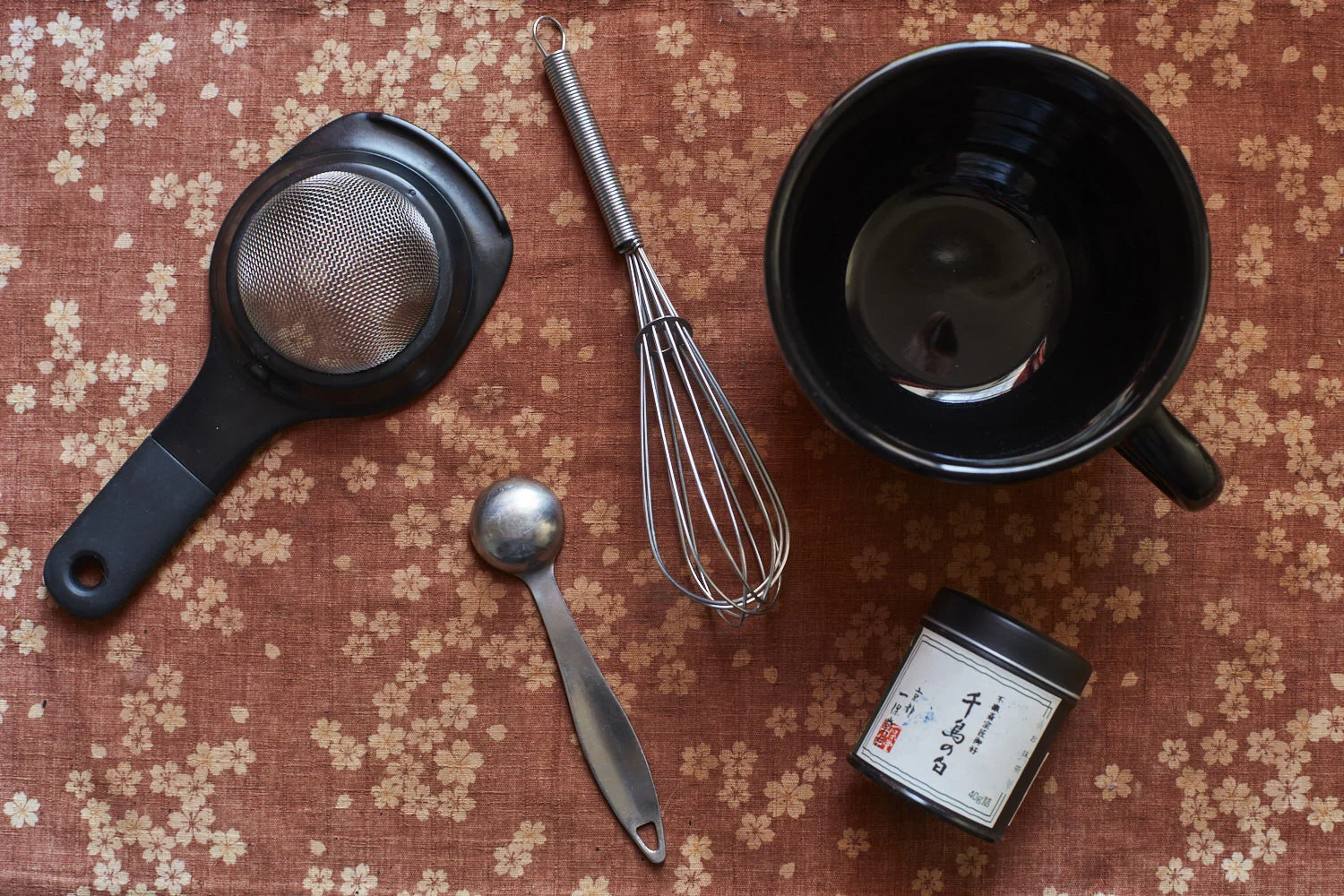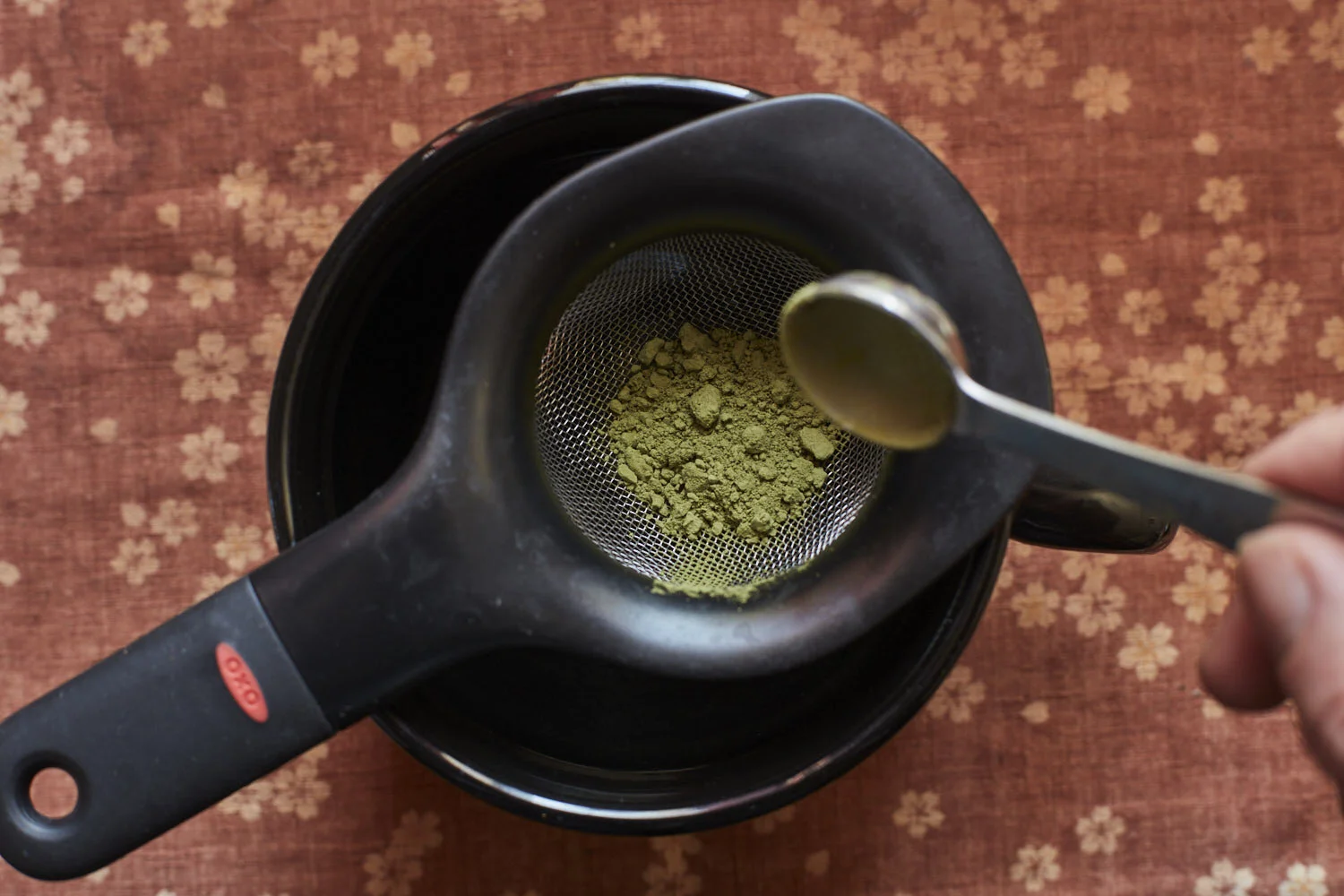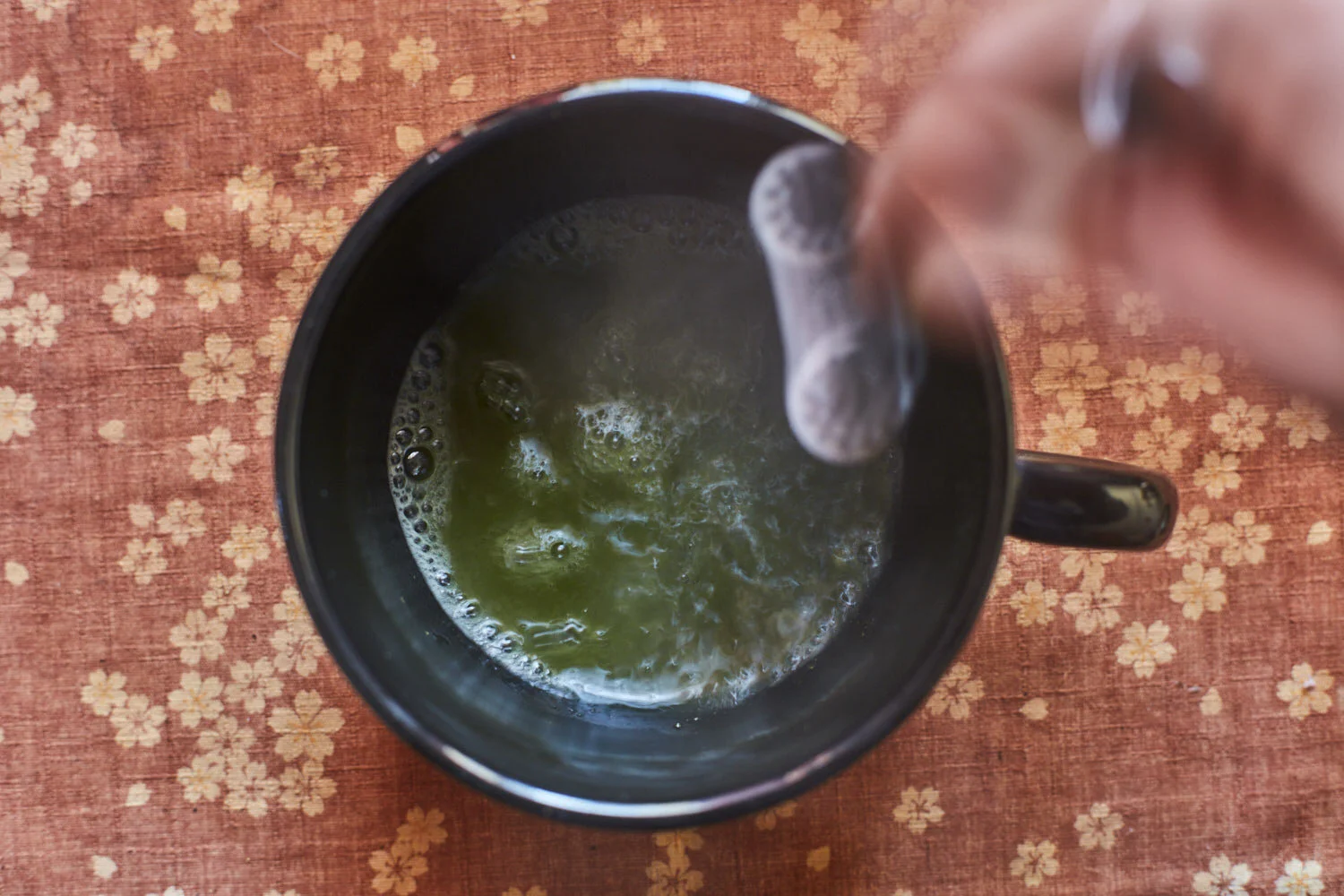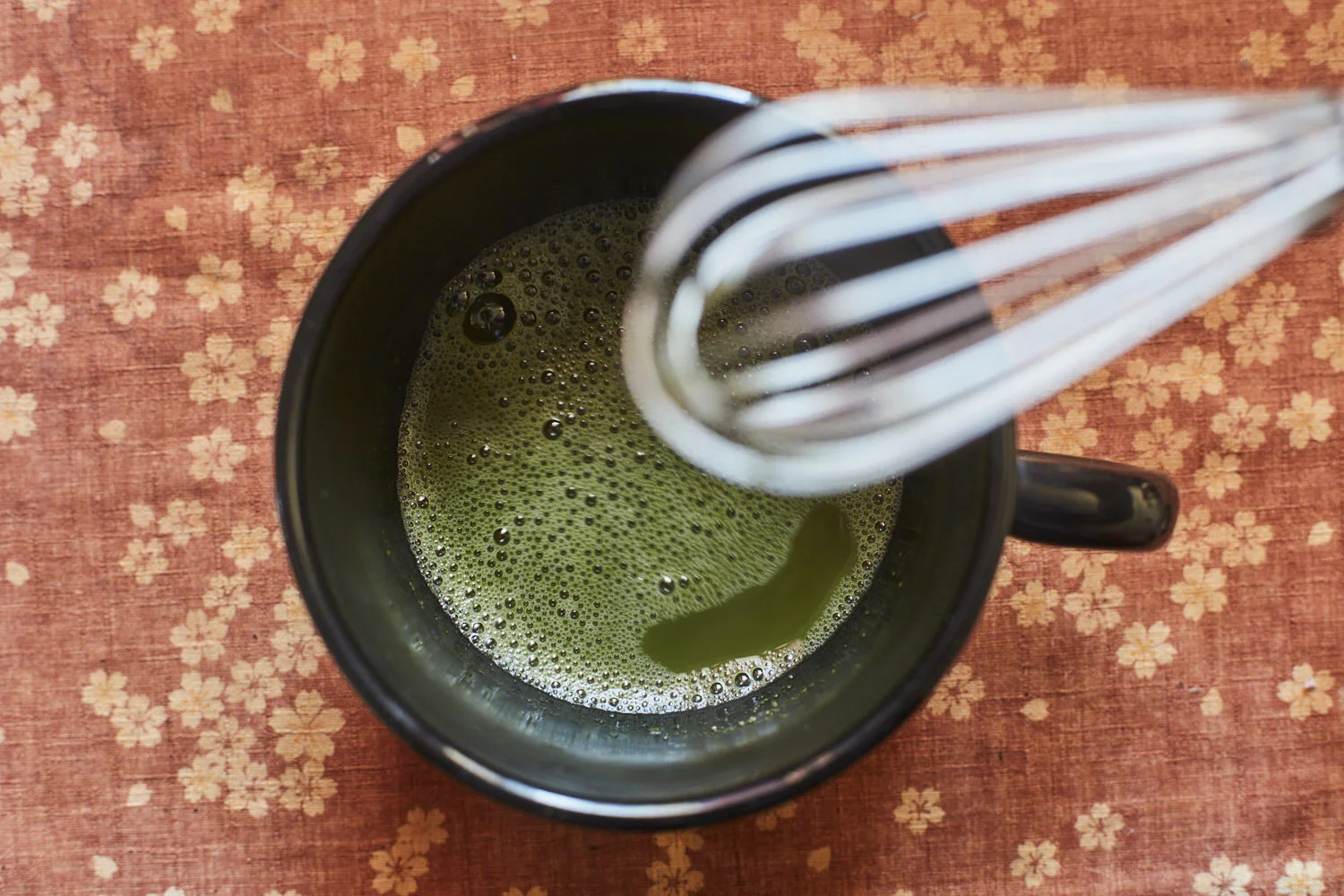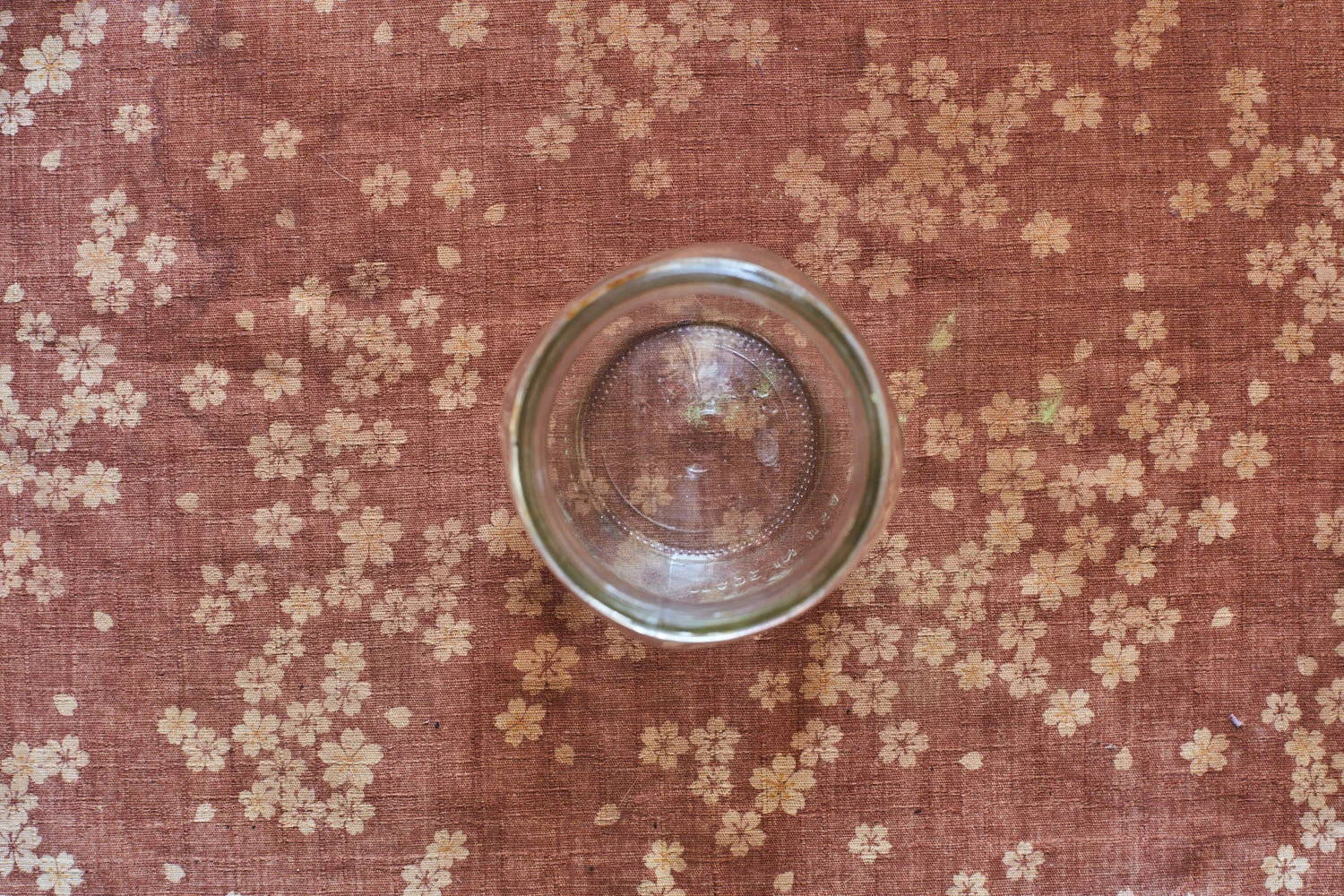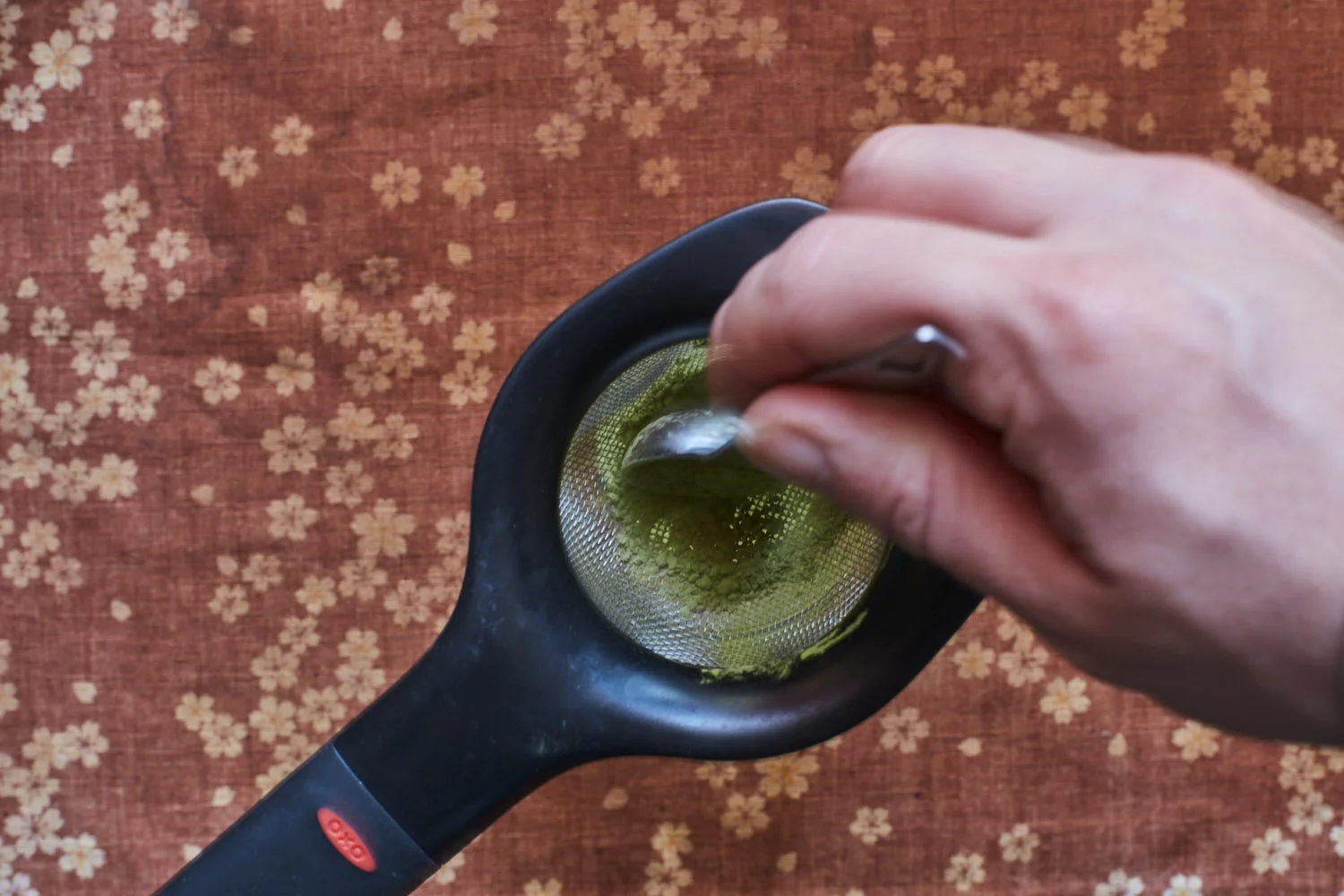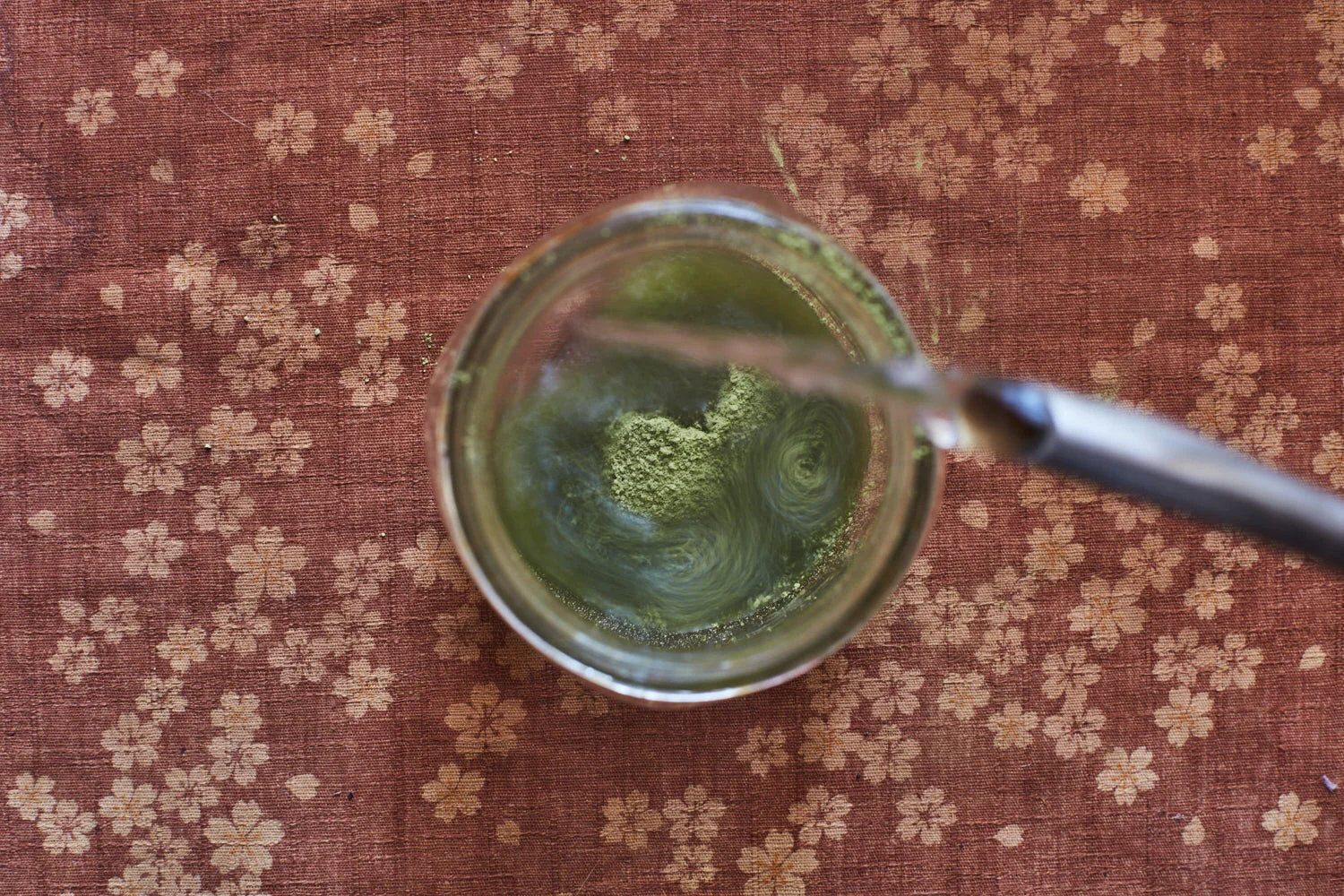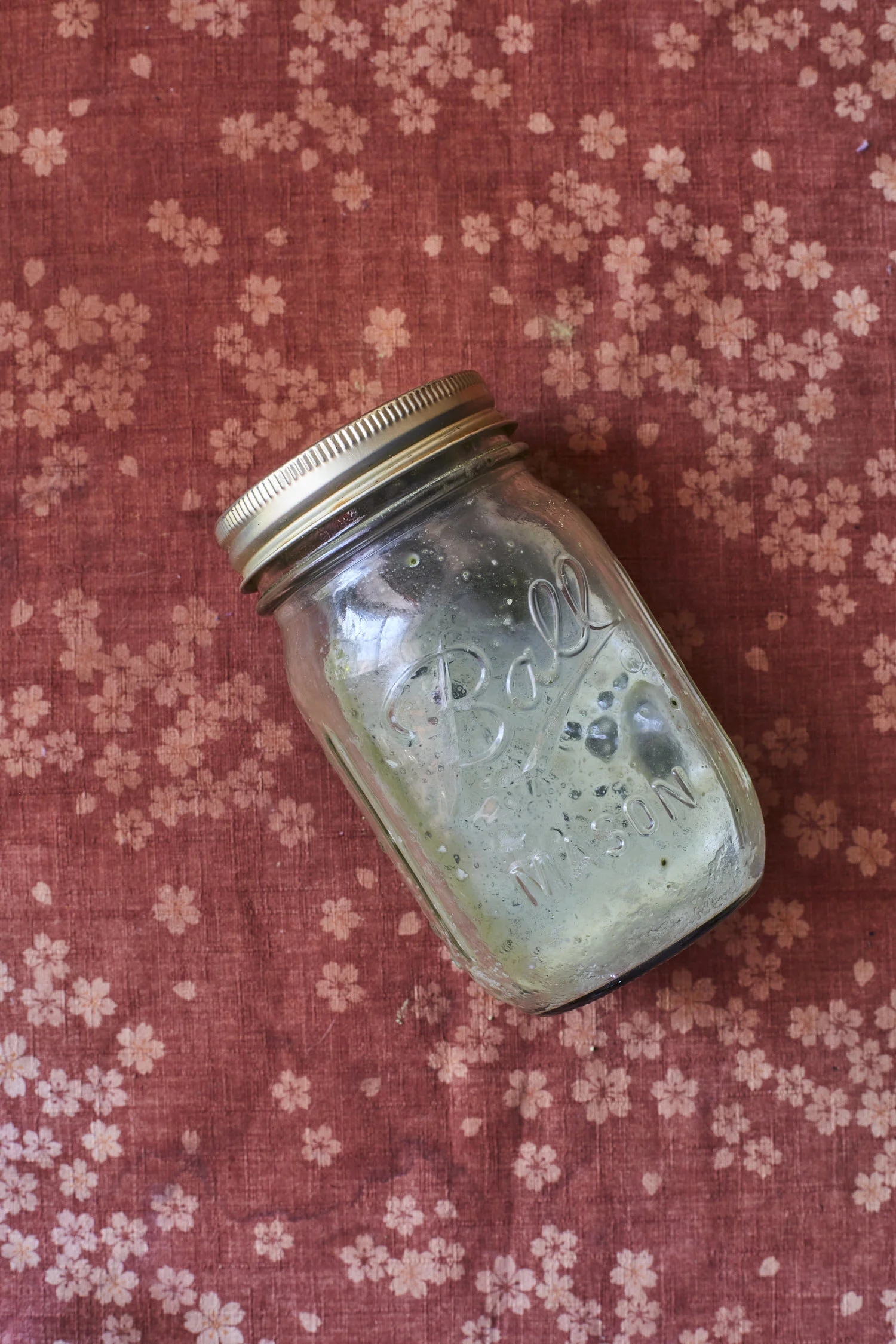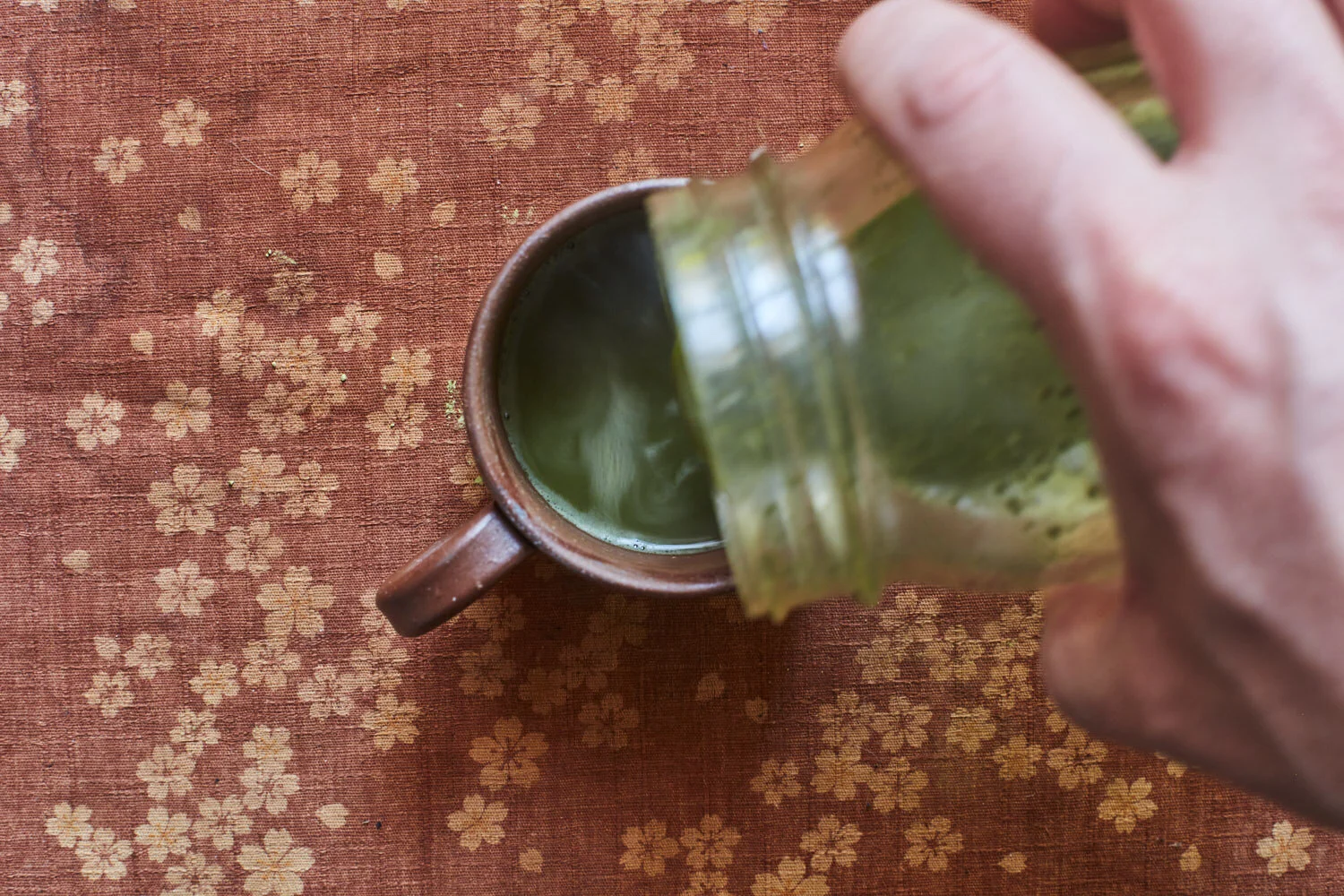How to Make Matcha at Home (Easy and Quick)
So you wanna make Matcha at home… But you don't have all the fancy tools, teaware, or a bamboo whisk? Don't worry!
I wrote this article to show you how easy it is to make Matcha at home with tools you already have in your kitchen. We'll also go over some Matcha basics and tips that will help you make a great cup of tea. So grab some Matcha and let's get started!
What is Matcha Green Tea?
Before we make Matcha at home… Let’s first briefly answer the question: what is Matcha?
Matcha is a Japanese Green tea that is stone-ground (which just means it's powdered.) Matcha powder is mixed into warm water then frothed with a bamboo whisk, and usually drank from a tea bowl called a chawan (茶碗).
Matcha is bright green, grassy, a little bitter, and a tad sweet. There's also a prominent savory brothy note known as umami (旨味). What sets Matcha apart from other Green teas is the fact that you're consuming the actual leaf.
Because the Matcha powder is whisked into the water, you're drinking tiny bits of the whole tea leaf (as opposed to a brew from loose leaf teas). Meaning you're also consuming the health benefits and antioxidants that Matcha is packed with. So that's why Matcha is a super healthy drink.
Matcha Health Benefits
It's no secret that Matcha is packed with health benefits. That's why (in my humble, totally non-biased opinion) Matcha is better than coffee. And also why it's part of my daily ritual…
The tea plant is loaded with nutrients, antioxidants, and other health-promoting compounds… But drinking Matcha allows you to get the most out of these compounds.
Why? It's simple – you actually consume the leaf when you drink the Matcha powder. Meaning your body can absorb more of the benefits than it could if you were just drinking a brew from a loose leaf tea.
What makes Matcha great for you is it’s packed with antioxidants and L-Theanine. All tea from the Camellia Sinensis plant contains an amino acid called L-theanine. In Matcha, it's responsible for the signature savory umami (旨味) taste.
When you consume L-theanine, it makes you feel relaxed and it counters some of the effects of caffeine. So even though you get a nice jolt of energy when you sip on Matcha, you're also getting a much calmer and focused state of mind.
We actually wrote a concise guide on everything you might wanna know about caffeine in Matcha. Alright… Now it's time to make some Matcha!
How to Make Matcha at Home
I'm gonna show you exactly how to make Matcha at home (a few ways even!) without any fancy Matcha tools or teaware. But! If you really like Matcha (or if you plan to get more into Matcha), the proper teaware is something you probably want to invest in.
Not only does it make a better cup of Matcha, but it also adds to the experience. With that being said, you can make a great bowl of Matcha quite simply.
Matcha essentially is just Green tea powder mixed into water. So it's not all that complicated to make. But there are a few things that'll make your cup of Matcha better. Let's get to it.
What You Need
Here's all you need to make some Matcha at home:
Bowl or mug
Teaspoon
Hot water
Matcha powder
Kitchen whisk
Helpful But Not Needed
Sifter (fine mesh strainer to push Matcha clumps through)
Thermometer
Because Matcha is ground into such a fine powder, it can stick together the same way hot chocolate powder does when you add liquid. Having a sifter is good because it can help break up the clumps which makes your life easier. But it’s not a requirement by any means.
A thermometer will help stop you from brewing your Matcha too hot. Boiling water should be avoided! More on that soon.
Steps
Here's how you make Matcha at home:
Boil water and let cool to 175F/80C (you'll be using about 8oz or 230ml)
2. Sift 2-4 grams (a generous 1-2 teaspoons) of Matcha powder into your bowl or mug.
3. Add your hot water and whisk!
The goal is to eliminate any clumps of Matcha powder, while also aerating the tea and forming small bubbles on top of the tea. It usually takes about 20 seconds to whip up a good froth.
If you notice that your Matcha isn’t doing that… It might be because you’re adding too much water. Remember the less water you use the foamier it will get.
Other Ways to Make Matcha at Home
If you don't have a whisk you can:
Mix the Matcha in a blender
Or use a milk frother
Or use a mason jar (which I'll show you in the next section)
Making Matcha in a Mason Jar
Here’s how you can make Matcha at home using only a mason jar. It’s really easy!
Boil water and let cool to 175F/80C (you'll be using about 8oz/230ml)
2. Sift 2-4 grams (a generous 1-2 teaspoons) of matcha powder into a mason jar
3. Add hot water and tighten the lid on (make sure it's on well and be careful)
4. Shake mason jar (again, be very careful, it's still gonna be hot)
Try to shake the Matcha enough so it's not clumped. This is especially important if you didn’t use the sifter which helps break apart the clumps. Pour into a cup or drink right from the mason jar.
I like to pour mine into a Japanese bizenware cup. Not only do they look really cool, but they also keep your tea a lot warmer than a traditional ceramic mug. (And they are said to alter the taste of coffee and tea.)
Trouble-Shooting 3 Big Matcha at Home Problems
It can be a struggle to make a great Matcha if you haven’t done it before. In fact, here are a few important tips to keep in mind to make sure your Matcha comes out right.
1 - Your Matcha tastes Metallic or Bitter
Strange taste in your brew? It might be because you have the wrong water temperature. In fact, proper water temperature is probably the most important aspect of making a good cup of Matcha.
Most Green teas (especially Japanese Green teas) are very sensitive to water temperature. So all you need to remember is this: don't use boiling water for Matcha!
Use water that has boiled and then cooled for a few minutes. The goal is hot water that is about 175F/80C. If your water is too hot or too cold, you might not get tea’s best flavor.
Quick tip: You can make your life easy by using half room temperature water and half boiling water. That way you know the temperature will be right without having to wait for the water to cool.
2 - Your Matcha isn’t Foamy When you Whisk it
When you make Matcha at home, do you find that it doesn’t foam upright? I’ve heard that from a lot of readers. I’ve found in 95% of cases the problem is you’re adding too much water compared to powder.
The less water you use, the more foamy your drink will be. I like to use a ratio of 1 to 30 or 60, Matcha to water. So if I use 2 grams of tea, I will use 60 to 120 grams of water.
60 grams of water will be more intense but will get foamy easily.
120 grams will be a more mild drink but might take a bit more whisking.
Anyhow, cut your water!
3 - Your Powder Doesn’t Taste Fresh
Are you finding that your tea tastes dull? I once gave a small class a lecture about Matcha and asked them what’s the primary taste they perceive with the drink. The #1 answer? It tastes “fresh.”
Well if your Matcha doesn’t taste fresh, it means you are buying low-quality tea, or maybe Matcha meant to be used for culinary purpose and not really for drinking… And there’s no fix I have for you other than to get better material.
However, if the stuff you buy is good, the problem might be your storage. Matcha hates sunlight and humidity. Keep your Matcha in an airtight container stored in a cool, dark, and dry place.
You can even keep your Matcha in the fridge. Just know that if you do, as soon as you open the jar the humid air will rush in and condense on the cold powder. Which will degrade it fast!
The best advice I have for you? When you first open your Matcha, consume it fast. Buy often in smaller quantities!
How to Make a Homemade Matcha Latte
A big reason you might have gotten interested in Matcha is that you like Matcha lattes. Fair enough, I do too! They can get expensive if you go to tea houses, and the ones at Starbucks are… Well, not really Matcha (Their “Matcha” powder is at least over 50.1% pure sugar).
So making it at home can give you more control over ingredients and quality. Anyhow, this is my own personal recipe to make a Matcha latte at home. If you give it a try, let me know what you think
So this recipe (which is mixed with your favorite plant-based milk) is a great starting point. The tea and the plant milk make a very palatable, creamy, and tasty everyday matcha drink
Matcha Tips
Here are a few things to get in mind when making Matcha:
Water temperature is key (you don't want the water to be too hot or too cold), 175F/80C is the goal.
Matcha powder will clump in water, so be sure to whisk well
Matcha should be stored in an airtight container in a freezer or refrigerator (this helps keep it fresh)
You'll want to use your Matcha powder within a few months of the opening so it doesn't oxidize too much (oxidation changes the flavor of the tea)
Join us at the Tea Table
Now that you know a little bit more about Matcha Green tea, all the easy ways to prepare it, and the basic mistakes to avoid– we'd love to hear from you. So if you found this article useful, don’t hesitate to leave us a comment.
And if you are looking for a true quality Matcha, I would like to invite you to try ours! We grind our Matcha in-house with a traditional Japanese stone-mill. And it’s always fresh (less than 30 days), so no dull and dubious tasting tea here. You can buy freshly-ground Matcha online here.
MORE ON MATCHA


